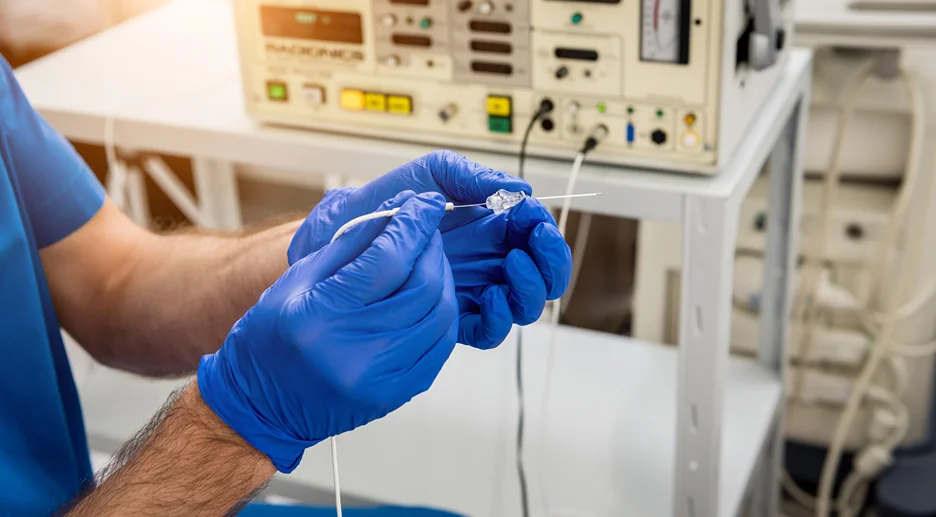Suffering from debilitating sciatic nerve pain? You’re not alone. Sciatica affects over 40% of adults at some point in their lives. But finding an effective long-term treatment can be a challenge.
If you’ve tried rest, medication, physical therapy and other conservative treatments without success, nerve ablation may be the answer. Keep reading to learn how destroying damaged nerve fibers with heat or cold could finally provide the sciatica relief you’ve been searching for.
What is Nerve Ablation for Sciatica?
Nerve ablation uses targeted heat or cold to destroy small nerve fibers along the sciatic nerve pathway. This disrupts their ability to transmit pain signals from your lower back down your leg.
One of the most common techniques is radiofrequency ablation (RFA). This uses radio wave energy to heat and deactivate specific nerves. Other options like cryoablation use extreme cold for similar results.
The goal is to turn off pain signals without impacting the nerve’s overall motor function. When done correctly, ablation can provide significant pain reduction for many sciatica patients.
How Does Radiofrequency Ablation Work?
Guided by imaging technology, a thin needle electrode is inserted near the painful sciatic nerve. Radio waves then heat and destroy the surrounding nerve fibers. This disrupts their ability to transmit pain signals to the brain.
RFA for sciatica can significantly diminish or halt pain messaging along the sciatic nerve. With nerves deactivated, inflammation and neuropathy are reduced, often for many months. Some patients experience permanent pain relief.
How Is Sciatica Radiofrequency Ablation Performed?

The minimally invasive procedure takes 30-60 minutes. Local anesthesia keeps you comfortable. Under imaging guidance, the radiologist inserts a thin needle electrode near the irritated nerve root.
Radio wave heat destroys a small portion of nerve tissue around the needle tip, interrupting pain signaling. You can go home the same day. Pain relief usually occurs within days or weeks as the ablated nerves die off.
Multiple ablation sessions may be required in some cases for the best results. The relatively non-invasive nature makes it a popular sciatica treatment option.
How Effective Is Sciatica Nerve Ablation?
Multiple studies have shown radiofrequency ablation can effectively reduce severe sciatica and back pain for extended periods. Patients report noticeable pain relief as soon as 10 days after the procedure.
Results from nerve ablation can vary case by case. Some patients only experience temporary reduction in symptoms, while others obtain long-term sciatica pain relief with ablation.
The treated nerves often regrow within 6-12 months after ablation. But repeating the procedure can help manage pain again. Talk to your doctor about the likelihood of ablation success based on your individual condition.
Can Nerve Ablation Provide Sciatica Relief?
Ablating irritated nerve fibers along the sciatic pathway can significantly reduce painful inflammation and neuropathy.
- RFA ablation aims to interrupt pain signaling by applying heat to targeted nerves.
- Cryoablation uses extreme cold for similar pain relief by freezing and destroying specific nerves.
For some patients, these minimally invasive procedures can have lasting effects and allow them to decrease use of pain medications.
Is Ablation for Sciatica Safe?
Ablation techniques like radiofrequency are considered safe and effective alternatives to more invasive back surgeries. Procedures are done on an outpatient basis using mild sedation.
Risks include standard surgical complications like infection or bleeding. Patients may experience mild pain, swelling or numbness near the injection site as nerves heal. Serious side effects are uncommon when performed by an experienced doctor.
For many, the potential rewards of long-term sciatica relief outweigh minimal risks. Always discuss your specific case with a specialist.
How Long Does Sciatica Ablation Last?
Relief duration varies by individual. Many patients enjoy 6 months to 2 years free from sciatic pain after ablation. Others find the effects wear off sooner.
Full relief can take 2-3 weeks to achieve as damaged nerves die off. Some patients report immediate pain reduction. Your doctor can give a better estimate based on your particular condition.
What are the Potential Side Effects?
While RFA is generally considered safe, there are potential side effects that patients should be aware of. The following are some of the potential side effects of nerve ablation:
- Superficial burning sensation over the treated area, similar to a sunburn
- Light skin numbness over the same area
- Mild headaches or dizziness
- Soreness at the injection site
- Hypersensitivity around the treated areas lasting up to two weeks
- Temporary numbness can sometimes follow the aforementioned two-week burning and hypersensitivity period
- Permanent nerve pain
- Bleeding
- Allergies or other reactions to RFA medications or anesthesia
- Infection
The Takeaway

Ablating damaged sciatic nerves could provide the long-term relief you’ve been missing. While not a cure-all, ablation often significantly reduces pain for extended periods by disrupting pain signaling.
Work with an experienced pain specialist to determine if a minimally invasive approach like radiofrequency ablation is right for your sciatica. Strengthen your back through exercise while avoiding re-injury, and you may find lasting relief.
At Kaly, we connect patients like you to top-rated doctors, physical therapists, chiropractors and more. Managing persistent sciatica can be frustrating, but our independent care advisors are here to help. Sign up for Kaly today to explore your treatment options and take control of your sciatic nerve pain once and for all.
FAQs
Is Nerve Burning a Good Option for Sciatica?
Nerve burning, or radiofrequency ablation, is an approach considered for chronic sciatica cases that do not respond to other conservative treatments. It aims to reduce pain signals by inflicting targeted damage to affected nerve fibers.
Can RFA Provide Long-Term Sciatica Relief?
For some patients, radiofrequency ablation of the sciatic nerve can have lasting effects and reduce or eliminate pain for years. However, results vary by individual.
When performed correctly by a specialist, ablation often successfully relieves sciatica pain for extended periods by disabling damaged nerve fibers. But nerves can regrow and pain may eventually return. Additional procedures may be required periodically.
Does Ablation Work for General Back Pain?
Ablating peripheral nerves that transmit pain signals from the spine shows promising results for various chronic back pain conditions. Specific nerves causing facet joint, sacroiliac and disc pain can be targeted.
Although nerves may regrow, repeat procedures can extend relief. Outcomes vary per patient and underlying cause. Discuss options with your doctor.
Can Doctors Cauterize the Sciatic Nerve?
In some cases, doctors may intentionally damage or destroy sciatic nerve fibers to provide pain relief. Minimally invasive options like radiofrequency ablation use heat to interrupt nerve signaling temporarily.
More involved surgical rhizotomy severs entire nerve roots. Chemical cauterization using silver nitrate has been studied in animals, but remains experimental. All aim for pain relief by disabling nerve transmission.
